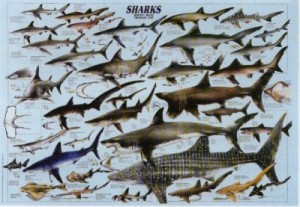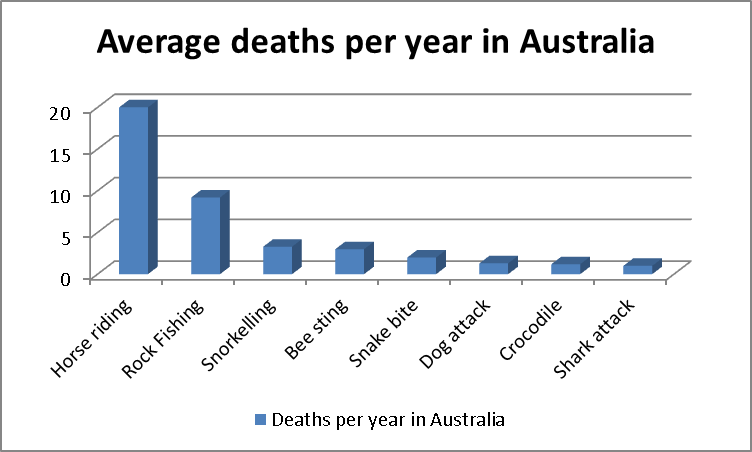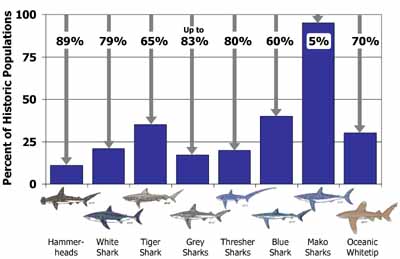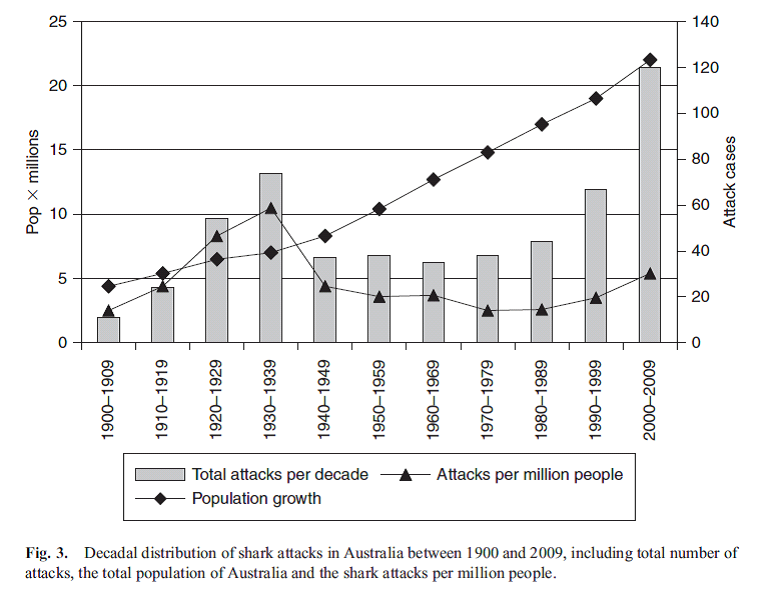Shark attack data
by Jillian Browning • April 9, 2014 • Announcements, Education, Research • 0 Comments
There has been a lot of talk about shark attack statistics and safety as a result of last weeks tragedy in Tathra.
We would like to allay peoples fear of sharks by presenting accurate and reliable data and statistics. We will then go through precautions to take to reduce the likelihood of attack.
 Sharks are an amazing ocean predator, there are over 510 species of shark in the world and of those 182 are found in Australia. Of these only three species are known to have caused fatalities in Australia; the White Shark (Carcharodon carcharias), Tiger Shark (Galeocerdo cuvier) and Bull Shark (Carcharhinus leucas).
Sharks are an amazing ocean predator, there are over 510 species of shark in the world and of those 182 are found in Australia. Of these only three species are known to have caused fatalities in Australia; the White Shark (Carcharodon carcharias), Tiger Shark (Galeocerdo cuvier) and Bull Shark (Carcharhinus leucas).
There are a number of hypotheses as to why sharks attack people, these include hunger, inquisitiveness (i.e. testing an object with their mouth to see if it is edible), mistaken identity or invasion of the shark’s personal space by the human. No one idea can be linked to all attacks as each shark-human encounter is unique to the shark and situation.
Firstly we all hear the idea that many things kill more people than sharks, such as bees, donkeys and even vending machines. Our Australian death statistics for 2012 come from the Australian Bureau of Statistics to compare shark attacks to other causes of deaths.

As you can see Sharks are responsible for 2 deaths out of 147,098, making up only 0.00136%. This is a very tiny amount.
Sharks are not the huge killers that are sometimes portrayed in the media or movies.
When looking at average deaths per year, sharks are even lower in the mix.
We have heard many people say that shark attacks are on the rise and this is actually true, but not because sharks are becoming more aggressive or increasing in number. Actually scientists believe that shark numbers are declining in Australia but require more data to be sure.
Here is research from the North Atlantic showing a dramatic decline in shark numbers from 1986.
Download the full research report, ‘Collapse and Conservation of Shark Populations in the Northwest Atlantic‘.
The increase in attacks is actually due to an increase in human population, increased beach usage, a rise in popularity of water based sports and also that people have access to more isolated locations than before.
This information is all included in a scientific paper written by John West (not the tuna guy), he is the Coordinator of the Australian Shark Attack File with the Taronga Conservation Society Australia. Have a read of the full paper Changing patterns of shark attacks in Australian waters.
Here is a graph (taken from the paper) from the data collected through John’s research. You can see in the graph that the number of attacks relates directly to the increase in population.
We can see in the data that shark fatalities do occur and they are on the rise as the population grows and more people partake in water sport activities. Here are some tips to help reduce the chance of shark attack.
This information is provided by the Taronga Conservation Society of Australia. For more information on shark attack data or safety visit http://taronga.org.au/animals-conservation/conservation-science/australian-shark-attack-file/prevention-shark-attacks/prevention-shark-attacks
Tips for safety
- Swim at beaches patrolled by Surf Live Savers (they are there to keep an eye on your safety, to look for signs of danger and to assist if you get into trouble).
- Do not swim, dive or surf where dangerous sharks are known to congregate.
- Always swim, dive or surf with other people (the presence of a companion may deter a potentially attack and your companion can assist you if you get into trouble or are bitten by a shark).
- Do not swim in dirty or turbid water (there is little chance of seeing a shark in these conditions).
- Avoid swimming at dusk, dawn or at night (many sharks are more active during these times and in low light conditions you may not be able to see an approaching shark).
- Avoid swimming well offshore, near deep channels or along drop-offs to deeper water (sharks are more likely to inhabit the deeper water).
- Avoid entering the ocean near a river mouth, especially after a rainstorm (rain can wash potential food items into the sea that might attract fish and sharks).
- If schooling fish congregate in large numbers, leave the water (sharks can be feeding on the baitfish schools).
- Do not swim near people fishing or spear fishing (as these activities can attract sharks).
- Dolphins in the area do not indicate the absence of sharks (dolphins and sharks sometimes feed together and some sharks feed on dolphins).
- Kayaker should raft up together if a large shark is seen in the area (this makes for a larger object that a shark may not be interested in).
- Do not swim with pets and domestic animals (sharks can be attracted to non-aquatic animals in the water).
- Look carefully before jumping into the water from a boat or wharf (people have jumped on top of sharks) and be aware that Wobbegong sharks are known to hide amongst the kelp in shallow water. Be careful wading through shallow water as you could accidentally step on one and get bitten without knowing it was there.
- Wearing shiny jewellry can reflect light that resembles the sheen of fish scales (sharks can be attracted to the reflected light).
- If a shark is sighted in the area leave the water as quickly and calmly as possible.
I hope that this information has been useful and put things in perspective for you. Please remember that the seas are the sharks domain and that they are a vital part of the oceans ecosystem.
If you have any questions please comment below or email us at education@sapphirecoastdiscovery.com.au




